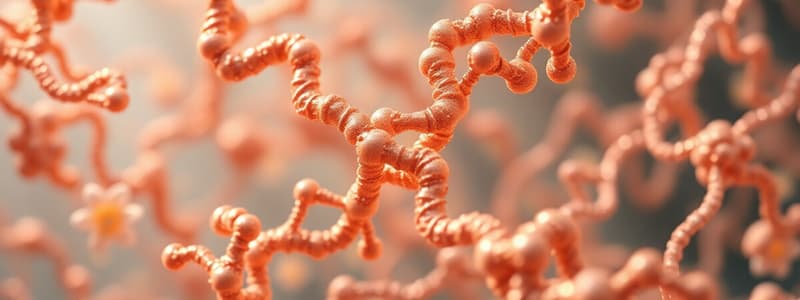Podcast
Questions and Answers
Which statement about the building blocks of macromolecules is correct?
Which statement about the building blocks of macromolecules is correct?
- Lipids are primarily composed of Monosaccharides.
- Proteins consist of Nucleotides linked by Peptide bonds.
- Carbohydrates are made of Glycerol and Fatty acids.
- Nucleic acids are made of Nucleotides connected by Phosphodiester bonds. (correct)
Which of these is not a type of symbiotic relationship?
Which of these is not a type of symbiotic relationship?
- Parasitism
- Commensalism
- Competition (correct)
- Mutualism
The bond between Glycerol and Fatty acids in lipids is known as what?
The bond between Glycerol and Fatty acids in lipids is known as what?
- Glycosidic bond
- Phosphodiester bond
- Peptide bond
- Ester bond (correct)
In mutualistic symbiosis, what is the relationship between the organisms?
In mutualistic symbiosis, what is the relationship between the organisms?
Flashcards are hidden until you start studying
Study Notes
Macromolecules Overview
- Four primary macromolecules: Nucleic Acids, Proteins, Carbohydrates, Lipids.
- These macromolecules are essential for various biological functions and structures.
Nucleic Acids
- Composed of nucleotides, which are the monomers.
- Phosphodiester bonds connect nucleotides, forming the sugar-phosphate backbone of DNA and RNA.
Proteins
- Made up of amino acids, which serve as the monomers.
- Peptide bonds link amino acids together, facilitating protein structure and function.
Carbohydrates
- Monosaccharides, such as glucose, are the basic units (monomers).
- Glycosidic bonds connect monosaccharides to form disaccharides and polysaccharides, which serve as energy sources and structural components.
Lipids
- Composed of Glycerol and Fatty acids as building blocks; do not have a clear monomer structure.
- Ester bonds, a type of covalent bond, link glycerol with fatty acids, forming triglycerides and other lipid structures.
Symbiotic Relationships
- Three main types of symbiosis:
- Mutualism: Both species benefit from the interaction.
- Commensalism: One species benefits while the other is neither helped nor harmed.
- Parasitism: One species benefits at the expense of the other.
Examples of Symbiotic Relationships
- Trichonympha and Termites: Mutualistic relationship where Trichonympha aids in digesting cellulose in wood for termites.
- E.coli and Humans: Commensal relationship; E.coli helps in digestion without harming the human host.
Studying That Suits You
Use AI to generate personalized quizzes and flashcards to suit your learning preferences.




